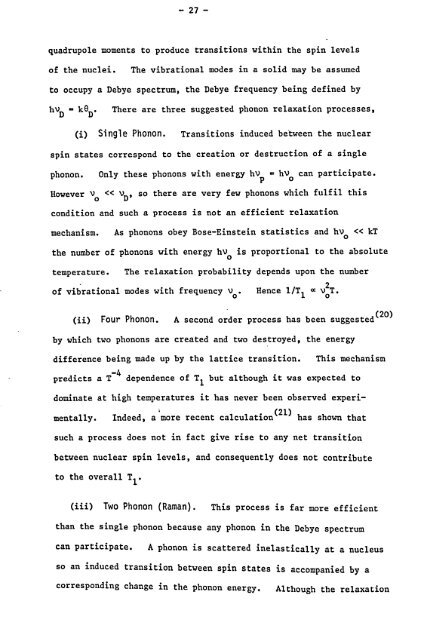NNR IN RAPIDLY ROTATED METALS By - Nottingham eTheses ...
NNR IN RAPIDLY ROTATED METALS By - Nottingham eTheses ...
NNR IN RAPIDLY ROTATED METALS By - Nottingham eTheses ...
You also want an ePaper? Increase the reach of your titles
YUMPU automatically turns print PDFs into web optimized ePapers that Google loves.
- 27 -<br />
quadrupole moments to produce transitions within the spin levels<br />
of the nuclei. The vibrational modes in a solid may be assumed<br />
to occupy a Debye spectrum, the Debye frequency being defined by<br />
hvD - keD. There are three suggested phonon relaxation processes,<br />
(i) Single Phonon. Transitions induced between the nuclear<br />
spin states correspond to the creation or destruction of a single<br />
phonon. Only these phonons with energy hvp = hV0 can participate.<br />
However V0 « VD, so there are very few phonons which fulfil this<br />
condition and such a process is not an efficient relaxation<br />
mechanism. As phonons obey Bose-Einstein statistics and hv0 « kT<br />
the number of phonons with energy hV0 is proportional to the absolute<br />
temperature. The relaxation probability depends upon the number<br />
2<br />
of vibrational modes with frequency V0. Hence l/T1 a v0T.<br />
(ii) Four Phonon. A second order process has been suggested (20)<br />
by which two phonons are created and two destroyed, the energy<br />
difference being made up by the lattice transition. This mechanism<br />
predicts aT4 dependence of T1 but although it was expected to<br />
dominate at high temperatures it has never been observed experi-<br />
mentally. Indeed, a more recent calculation<br />
(21) has shown that<br />
such a process does not in fact give rise to any net transition<br />
between nuclear spin levels, and consequently does not contribute<br />
to the overall<br />
Tl.<br />
(iii) Two Phonon (Raman). This process is far more efficient<br />
than the single phonon because any phonon in the Debye spectrum<br />
can participate. A phonon is scattered inelastically<br />
at a nucleus<br />
so an induced transition between spin states is accompanied by a<br />
corresponding change in the phonon energy. Although the relaxation

















